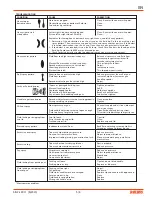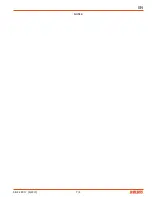
EN
SB-2-187-H (6/2015)
1 / 8
SERVICE MANUAL
JGA-510-98FX
PRESSURE FEED HIGH VOLUME
LOW PRESSURE SPRAY GUN
MODEL NUMBER
JGA-510-98FX Full Size Gun Body
DESCRIPTION
xxx-xxx
Body Stamped
JGA-510
The JGA-HVLP pressure feed gun incor-
porates a LOW CFM HVLP air cap (#98)
which is capable of spraying a wide variety
of materials (low to medium solids), at
fluid flows typically in the 7 to 10 ounce/
minute range.
Air consumption for the #98 air cap is
approximately 11 SCFM @ 10 psi cap
pressure. Inlet air pressure of approxi-
mately 30 psi (measured at gun handle,
flowing) is required to achieve 10 psi cap
pressure. The actual air cap pressure can
be verified by using an air cap test kit (see
Accessories, page 6).
The gun model also includes a conver-
sion air baffle, which converts the higher
incoming pressure to low pressure (HVLP).
All other components, with the exception
of the air cap and baffle, are identical to
other conventional air spray JGA-510
models.
This gun model includes 300 series stain-
less steel needles and 400 series fluid tips.
See page 3 for the 300 series tip and needle
which may be ordered separately. This
gun can be used with chlorinated solvent
materials, but see page 2 for additional
warnings.
IMPORTANT: Before using this
equipment, read all safety precau-
tions and instructions. Keep for
future use.
Air Cap Stamped
98 HVLP
Baffle Stamped
Max. 30 PSI, 98
IMPORTANT: This gun may be used with
most common coating and finishing ma-
terials. It is designed for use with mildly
corrosive and non-abrasive materials. If
used with other high corrosive or abra-
sive materials, it must be expected that
frequent and thorough cleaning will be
required and the necessity for replacement
of parts will be increased.
INSTALLATION
Connect the spray gun to a clean, oil and
moisture free air supply. The air inlet
(located at the base of the gun handle)
includes a 1/4" NPS (M) connection.
Be sure to use hose with an ID of at least
5/16". DO NOT use 1/4" ID air hose which
is restrictive and will cause excessive
pressure drop (example - at 18 CFM, 25
ft. of 1/4" hose has a pressure loss of 25
psi, but 25 ft. of 5/16" hose at 18 CFM has
a pressure loss of only 8 psi).
If quick air disconnects are required, use
only higher flowing models approved for
HVLP use, such as those shown on Acces-
sories, page 6. Other types or brands may
be restrictive and may not flow enough air
for proper gun operation.
Connect the fluid hose to the fluid inlet
connection (3/8" NPS) located under the
spray head. Properly tighten with a wrench.
OPERATION
Strain material thru 60 or 90 mesh screen.
Adjust fluid pressure to deliver the desired
paint volume. Adjust air pressure and flow
to provide a uniform dispersion of atom-
ized paint throughout the pattern. Keep air
pressure as low as possible to minimize
bounce-back and overspray. Excessive
fluid flow will result in heavy center spray
patterns. Inadequate flows may cause the
pattern to split. See TROUBLESHOOTING,
page 5, if any problems occur.
For maximum transfer efficiency, do not
use more air pressure than is necessary
to atomize the material being applied. Ex-
cessive air pressure will create additional
overspray and bounce-back, reducing
transfer efficiency.
If an air cap test kit is used (see Accesso-
ries, page 6), verify air cap pressure after
acceptable atomization is achieved. Make
a note of the air cap pressure for future
reference and daily process control.
PREVENTIVE MAINTENANCE
To clean air cap and fluid tip, brush exte-
rior with a stiff bristle brush. If necessary
to clean cap holes, use a broom straw or
toothpick. Never use a wire or hard in-
strument. This may scratch or burr holes
causing a distorted spray pattern.
To clean fluid passages, remove excess
material at source, then flush with a suit-
able solvent using a device such as the
SolventSaver
TM
(See ACCESSORIES). Wipe
gun exterior with a solvent dampened
cloth. Never completely immerse in sol-
vent as this is detrimental to the lubricants
and packings.
SPRAY GUN LUBRICATION
Daily, apply a drop of SSL-10 spray gun
lube at trigger bearing stud (20) and the
stem of the air valve (12) where it enters the
air valve assembly (16). The shank of the
fluid needle (32) where it enters the pack-
ing nut (18) should also be oiled. The fluid
needle packing (17) should be lubricated
periodically. Make sure the baffle (5) and
retaining ring (1) threads are clean and
free of foreign matter. Before assembling
retaining ring to baffle, clean the threads
thoroughly, then add two drops of SSL-10
spray gun lube to threads. The fluid needle
spring (29) and air valve spring (11) should
be coated with a very light grease, making
sure that any excess grease will not clog
the air passages. For best results, lubricate
the points indicated, daily.
Major Repair Kit KK-4987-2
Minor Repair Kit KK-5034


























